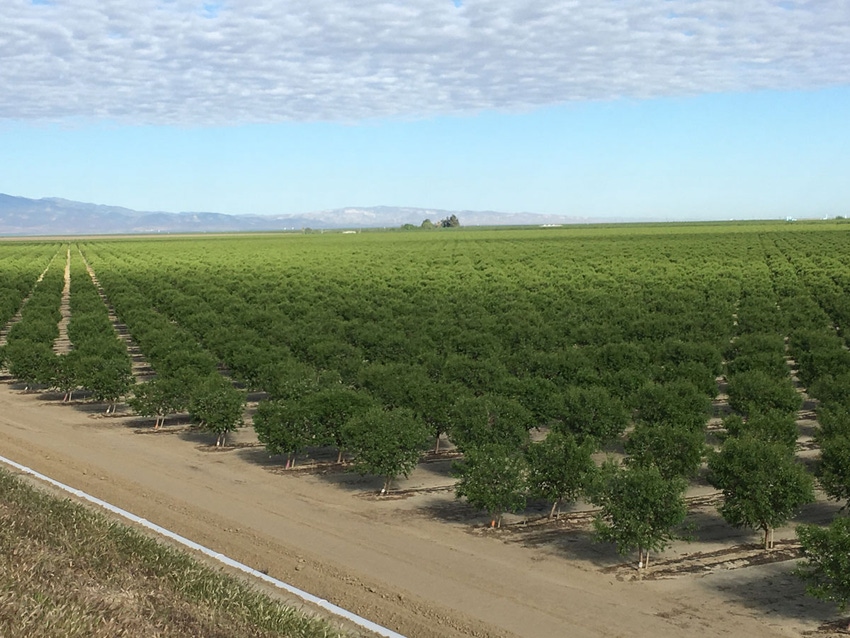May 4, 2016

By the second week of April, the nuts in Borba Farms’ West Side almond orchards had begun to fill in the process of producing a crop with the potential to be respectable.
“All of our varieties look good,” says Mark Borba.
The varieties Nonpareil, Aldrich, Monterey , Fritz, Wood Colony, Butte, and Padre grow on one-fourth of the operation’s 9,000 acres of farm land near Huron, Calif.
Like many almond growers this year, he was surprised by an early Monterey nut drop. This followed what appeared to be a well-coordinated bloom, concentrated within just a 10-day period, between the Nonpareil and the two or three pollinator varieties in each orchard, allowing for good pollination, Borba says.
“We had near-perfect temperatures then, without any rain or wind,” the grower says. “The bees were strong and working hard. All of us were anticipating a huge set.”
To explain the unusual Monterey nut drop, Borba doubts it was caused by poor bee performance in his orchards. His contract calls for 10-12 frames of bees per hive.
“We checked the hives which in many cases had 14-15 15 frames. They were full of good, healthy bees,” says Borba. “Normally, the bloom extends over three to four weeks. Maybe, with this year’s flash bloom, the bees just didn’t have enough time to pollinate all the flowers.”
Meanwhile, he is focused on bringing his young crop to maturity.
Borba says, “Now we need to find adequate water to make this happen.”
This promises to be a heavy haul.
“I get up every morning with fingers crossed that water will continue to be available this season,” he says.
North of the Sacramento-San Joaquin Delta, rivers and reservoirs are brimming with water in the wake of the heaviest winter rainfall in five years. As a result of this and a thick snow pack in the mountains, growers in the Glenn-Colusa Irrigation District were allocated 100 percent of their requested surface water deliveries this year.
However, Borba and other growers in the 600,000-acre Westlands Water District, located south of the Delta, were more than a little dismayed to learn in early April that, after receiving no surface water from the federal Central Valley Project for the past two years and despite the El Nino rains of this past winter, they can expect to receive just 5 percent of their full allotment.
This water comes from the Delta where environmental regulations to protect endangered native fish, including Chinook salmon and Delta smelt, have restricted the amount of water pumped out of the Delta southwards to growers and other users.
“The 5 percent allocation is just a token,” Borba says. “It’s very frustrating.”
The Delta pumping restrictions will put even more pressure on declining supplies of groundwater in this area of the San Joaquin Valley, as growers continue to draw water from wells to irrigate trees and other crops.
Increasing salinity of the ground water is also a concern to growers. Borba’s sampling of soils from depths of 1, 3, and 5 feet deep show salinity levels are increasing.
“I’m seeing salt burn around the edges of leaves in some varieties more sensitive to saline conditions than others.”
Borba says, “So far we haven’t seen any decline in nut set or nut yields from higher soil salinity. However, I anticipate this will happen eventually without higher quality surface water.”
The shortage of surface water in this area is also showing up in the form of numerous well rigs at work, as growers lower pump levels, replace pump motors, and install new bowls.
“Some wells around here are 40-50 years old and (are) failing - pumping only sand and gravel,” he says.
Opportunities to use excess surface water purchased from other water districts are also limited.
“Locating supplies of available water elsewhere isn’t the problem,” the almond grower says. “Instead, it’s getting the water through the Delta because of the pumping restrictions. Even when water can be pumped south, it goes first to those with senior water rights.”
Meanwhile, Borba and his neighbors have benefited from some welcome help from Mother Nature. During the second weekend in April, his almond orchards received about one-third to one-half inch of rain. He notes that some fields not far away received about 2.5 inches.
Rainfall in his area has totaled about 8-8.5 inches since the first of October.
“We’ve had good rains that were pretty evenly spaced and helped leach salts out of the root zone.”
In addition to his drip-irrigated almond orchards, Borba Farms also includes tomatoes, garlic, lettuce, melons, and Pima cotton. This combination helps spread out the demand for water which allows well use for the crops at different times of the year.
For example, most of the almond tree water use occurs from April through June. Water demand by cotton is highest from June through August. The tomatoes need water from January through June.
Borba sees signs that almond prices, which plunged to just half or more since last August, are headed higher.
Based on a report received from his packer in mid-April, Borba says that although shipments of almonds to buyers in March were down 15 percent from a year earlier that total shipments to date for this marketing year are down just 7 percent.
“Rather than looking at the volume of almonds that have been shipped, I’m looking at the amount sold, even if not yet shipped,” Borba says. “Those sales are up 21 percent over last year. I don’t think the market outlook is as bleak as many growers seem to think.”
You May Also Like




